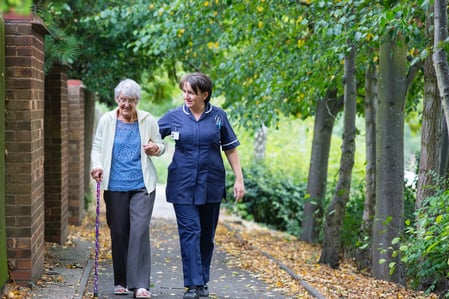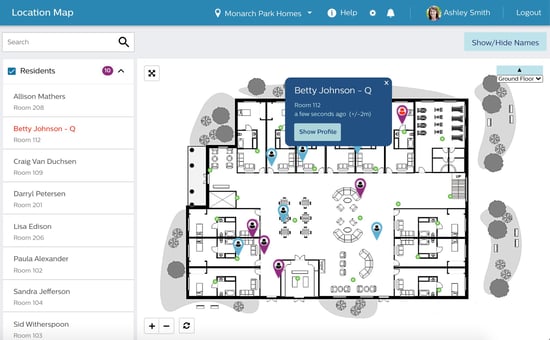Loneliness and social isolation have always been factors that have concerned senior living communities. Research has shown a variety of factors that contribute to seniors’ isolation, including the loss of a spouse, separation from family and peers they connect with, as well as serious illnesses and hearing loss.
Keeping elderly residents from feeling isolated during the pandemic has been a challenge. For some senior living communities, it has also provided opportunities to get to know residents better and be more prepared to prevent occurrences of loneliness among them.
Even as restrictions ease and vaccine rollouts to residents are nearly completed, the risk of isolation still remains. The senior living operators we work with have been doing a lot to combat resident isolation and we wanted to share these experiences with our community. We believe these tools will become standard practices for preventing isolation, even after the pandemic.
Here are six strategies operators have employed to combat isolation in their communities:
1. Using Digital Activities To Fuel Engagement
Technology is sometimes criticized for making humans more antisocial. However, when used in the right way the opposite can be true. Tablets are an easy way to get elderly residents to use technology independently. With everything from guided meditations, performances, and exercise videos online, preloading tablets with various content that residents will engage with is a great place to start. Studies show that by lowering the learning curve, there is more of a chance that residents will feel comfortable using this technology by themselves.
Introducing residents to a few simple software apps — such as radio stations that play classic tunes they can recognize — is a relatively quick way to bring engagement and entertainment into their lives. Remember that many residents may have not used Zoom or Skype to talk to their loved ones. Take the time to walk residents through using these tools until they feel comfortable using them regularly. Being able to see and speak to their loved ones can significantly increase feelings of connectedness.
Studies have shown that more and more boomers are turning to video games as forms of entertainment. Video games can help residents engage new parts of their brains that require fast decision-making skills, hand-eye coordination, memory, and auditory perception. Any games that require complex tasks and learning and remembering new skills is worthwhile. Whether on an app or a computer monitor, gaming tech can be used to keep senior residents' minds fresh.
Technology can help senior living residents feel like they have more autonomy in their daily lives. When so much choice is taken away from residents, giving them the power to make their own decisions is important. Finding a resident safety system that includes voice integration software like Alexa can help. Residents can easily ask what the community entertainment schedule is like today or request their favorite songs without seeking out staff for assistance. Putting more control into residents' hands helps boost their self-reliance and self-esteem.

2. Discovering Your Residents Interests & Talents
Many senior living communities include activities and experiences in their weekly schedules. With limited visits or events in their days, it’s more important than ever that residents have a wide variety of things to do. Caregivers could create individualized, personal engagement packages based on the resident's interests to keep them engaged. These could include short stories, “this day in history” trivia, and other pieces of information based on each resident's life or interests.
Additionally, many residents will have had hobbies or talents that they haven’t had a chance to engage in for a while. Allowing residents to explore new sides of themselves is essential. Art supplies, knitting, drawing, crochet, whittling, and other crafts are all creative and stimulating past times that require concentration and creativity. Get to know what your residents like or have always wanted to try out and provide a space for them to do it.
3. Being Creative With Social Programing
With social distancing measures still in place, some communities turned this problem into an opportunity. Doorway activities are all about bringing fun to the residents. From the safety of their doorway, senior living residents can join in musical sessions, games, and sing-alongs without risking their safety. This measure also enables residents to benefit from social interaction when they would otherwise be in their rooms.
Hallway parties are another way to bring novelty to senior living communities. Decorating hallways where residents live and having the entertainment performed in a different part of the community makes these events feel a little more special.
Group activities have been shown to improve quality of life and fostering friendships is important. From book clubs, and sewing clubs, to themed movie nights and regular game nights, residents can feel more involved in their community and give suggestions on upcoming events. Many religious groups and community organizations moved their services online during the pandemic. With a little research, bringing these services and groups into your community is relatively easy and quite impactful.
4. Getting Senior Living Residents Moving

With access to technology, senior living residents can get active in various ways. Exercise has been proven to improve everyday function in long-term residents. From group exercise classes that get their heart rates up to personalized exercises that they can do in their rooms, increasing step counts throughout the day is essential. For many residents, dancing is another enjoyable way to get moving and engage with their peers.
As the weather improves, you can utilize the outdoor space you have at your disposal. With less traffic around, using empty areas like driveways and parking lots for exercising and walking is a great way to get some fresh air without risking close contact with people outside the community.
5. Using Technology To Monitor Staffing, Well-being & Outbreaks
Analytical data can help combat isolation and loneliness in surprising ways. With advanced resident safety technology, operators can see resident and staff movement and understand how staff prioritizes their time. Data can show inefficiencies related to time spent with residents and how long it takes for them to respond. This information can be used by operators to make improvements to daily staffing to provide better care.

This same technology can show mobility scores in senior residents. When these are low, staff can intervene by encouraging participation in exercise programs to get them moving. Proximity data also shows when residents are spending too much time on their own, indicating possible social isolation concerns. These resident insights can be accessible to families through remote real-time family portals, providing wellness information to residents and their families.
6. Prioritizing Safety With Clear Communication
For many residents, not being able to see their families has been one of the hardest parts of the pandemic. During seasonal outbreaks in the future, residents need to know that they can access communication tools like Skype or Zoom at any time. This keeps residents feeling connected and autonomous when it comes to communication.
While senior living communities take some decision-making out of the hands of residents, being transparent with communication will give your residents a sense of inclusion. Tell residents what is planned for them and why. Being transparent about keeping residents informed and safe helps foster a sense of trust between residents, staff, and operators. Extending this communication to residents' families can also go a long way.
Advanced Technology Helps Balance Safety & Well-being
In a post-pandemic world, the focus is no longer just on keeping senior living residents safe physically, but also mentally well. Part of this wellness depends on getting to know residents better by understanding their needs, interests, and behaviors.

Finding time to spend with residents can be hard for staff as more immediate and pressing tasks take away their time and attention. With the right technology, they can do both. Advanced technology solutions can help make caregivers’ jobs easier and can be the backbone of a healthy community.
Investing in technology to help keep residents connected is not just relevant during a pandemic. For residents far apart from their families, providing the tools for digital connection, and forging strong bonds between staff and residents is good for long-term mental well-being.
By leveraging insights into how residents behave, staff can understand where to prioritize their needs and provide enhanced personalized care. From exercising to socializing, this technology offers a safer way to manage loneliness and prevent feelings of isolation. For senior living communities, staff, residents and families can feel empowered and able to rely on technology in a whole new way.
For more information on Lifeline Senior Living's resident safety and community management systems, please reach out to request a demo and learn more.

